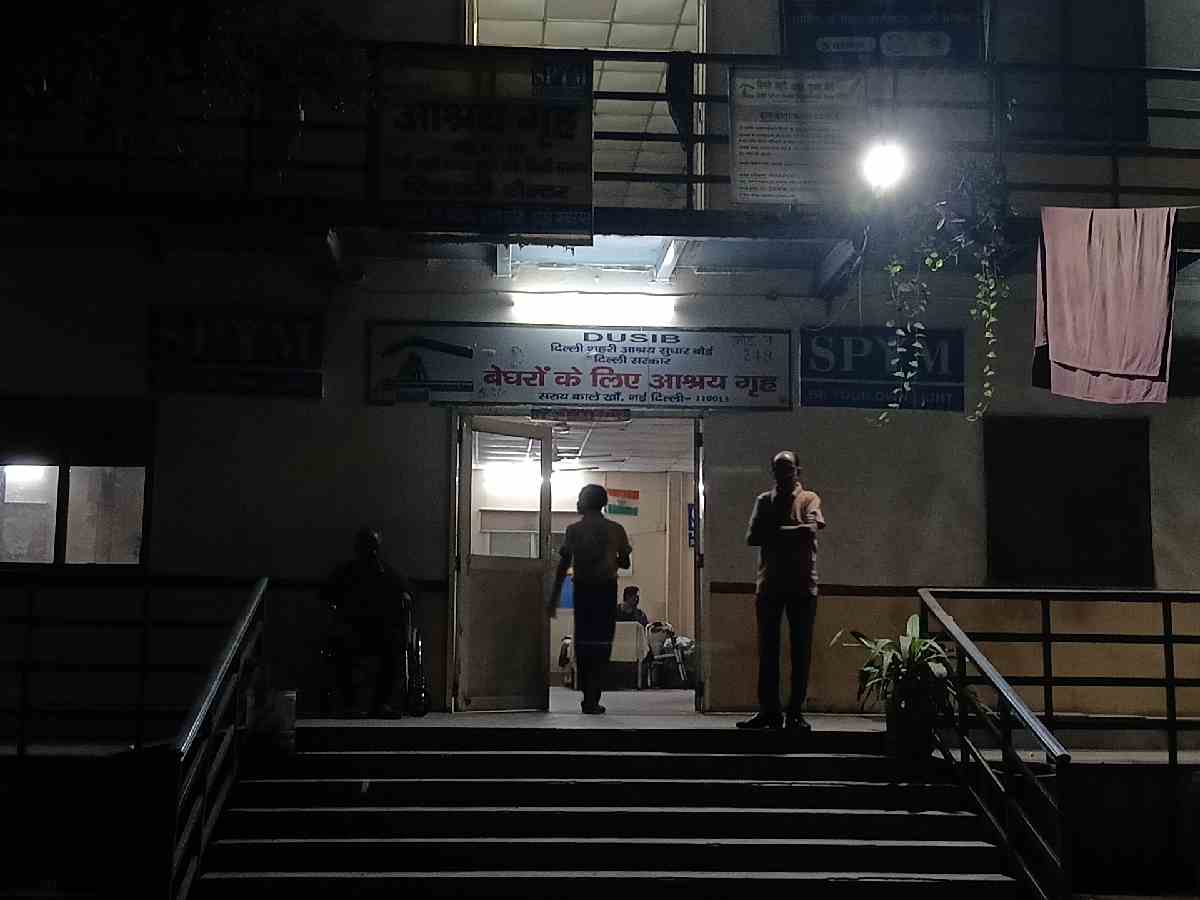
OFFERING HOPE: The male-only shelter and recovery centre at Sarai Kale Khan
With winter knocking at Delhi’s door, the homeless are once again set to bear the brunt of the harsh weather in the national capital. With no significant provisions in place to address the impending cold wave, residents of many night shelters are left to fend for themselves.
In 2017, Imran Hussain, the then-Environment Minister in the Aam Aadmi Party (AAP) government, directed officials to ensure that electric heaters were provided to all night shelters and security guards at government offices. Reportedly, in a letter to the Delhi Pollution Control Committee (DPCC), Hussain wrote, “Provide electrical heaters to security guards in cold winter nights to discourage burning of biomass for heating. Non-biomass heating facilities should be provided at all night shelters.”
However, this order was never implemented as the DPCC failed to inform the Delhi Urban Shelter Improvement Board (DUSIB). As a result, residents of homeless shelters were left to their own devices, with many succumbing to the harsh Delhi winter.
Despite the directive issued by Hussain in 2017, no corrective measures were taken by the DUSIB.
The DUSIB said there has been no provision included by the shelter improvement board to incorporate the usage of electric heaters for the homeless in night shelters.
“We have not been informed about any provision regarding the inclusion of electric heaters. Normally, we do not use these as they may cause short circuits,” said Mahesh Bhardwaj, Executive Engineer at DUSIB.
The Centre for Holistic Development (CHD) recorded approximately 106 deaths in January, though DUSIB officials denied these figures. Meteorological reports also indicate that January this year was Delhi’s coldest winter in 13 years, with maximum temperatures hovering around 17°C.
Shelter residents primarily rely on biomass fuels and makeshift fireplaces to ward off the cold. While they prepare to gather sticks and fuel to light fires across the compounds by the end of the month, the lack of preparation from authorities has become a growing concern.
Children, in particular, are the most vulnerable during the winter months. According to residents, many children walk around without sweaters or jackets, and at night, they rely solely on blankets provided by the shelter authorities. However, these blankets often go unused.
“All the blankets have bed bugs and lice. Using them is more of a health hazard than facing the cold. Every time I’ve used one, I’ve woken up with hives all over my body and struggled to get out of bed the next morning,” said Uma Devi, 30, a resident of the night shelter near Sarai Kale Khan metro station.
Similarly, Reema Devi, 26, a resident of the Nehru Place night shelter, shared, “Even though the blankets are regularly washed, the issue of bugs and ticks persists. We’ve stopped using them entirely. Some of us have our own blankets, bought or received as donations, but none of us use the ones provided by the shelter. Many have sold or thrown them away.”
Delhi has around 343 night shelters. According to the Occupancy Report, their total capacity is 20,264. However, a survey by Shahri Adhikar Manch: Begharon Ke Sath, an organisation of NGOs working with the homeless, revealed a staggering disparity. The headcount survey found approximately three lakh homeless people in Delhi, leaving over two lakh individuals without shelter during the winter season.
Also Read: Delhi’s fight against pollution hit by staff shortage
Of the 343 shelters, 82 are reinforced cement concrete buildings, 103 are porta cabins, 10 are designated as Special Drive shelters, eight are temporary buildings, and 140 are tents.
“We will set up the special winter tents by the end of November, and they should be operational by early December. Our winter rescue missions will also commence to bring the homeless into shelter compounds,” said Shri Ram of Janpahal, the NGO managing the Sarai Kale Khan night shelter and others in East Delhi.
However, the lack of provisions for the current homeless population poses significant challenges. According to Ram, the Occupancy Report’s figures are inflated. “The figures were calculated before the beds were introduced. Now, most beds accommodate two people, and there’s still not enough space. Many are forced to sleep on the floor. Hopefully, the additional tents will alleviate some of the pressure, but without them, many more could fall ill,” he said.
He added that while shelters keep more blankets than the reported capacity, these often remain unusable due to the bug infestation.
With a rising influx of homeless individuals and unusable blankets, the options become limited to burning biomass fuels or acquiring electric heaters. The latter remains a stalled governmental idea, leaving the former as the only viable solution, albeit one that contributes to air pollution.
Ravikant, from Sofia, another NGO maintaining night shelters in Central Delhi, explained the reluctance to use electric heaters. “There were discussions initially, but the plan was never implemented by DUSIB or the government due to concerns over short circuits potentially causing fires. Since the idea was shelved, we haven’t pursued it formally, though it remains a topic of informal discussion.”
Ram noted that convincing the homeless to use shelters is itself a significant challenge. “Even when we bring them in, they often leave at the first opportunity. Many prefer to stay near their places of work, even in the freezing cold,” he said.
Delhi Police raided a late-night illegal bar in Samaypur Badli, detaining 25 people and seizing…
A rear-end crash near Delhi Haat triggered a blaze that gutted both vehicles, though no…
Court grants probe agency more time as NIA pursues wider links in Red Fort blast…
Featuring works in thread, fabric, performance and digital media, Ski(e)n examines the body as a…
Govt report shows gains in maternal health, with better care access and fewer anaemia cases…
Delhi driver murdered after petty dispute; birthday celebration turns violent, say police